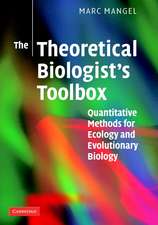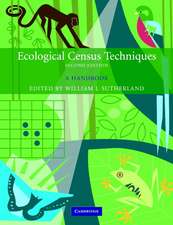Insect Populations In theory and in practice: 19th Symposium of the Royal Entomological Society 10–11 September 1997 at the University of Newcastle
Editat de Jack P. Dempster, Ian F.G. McLeanen Limba Engleză Paperback – 5 noi 2012
Entomologists have played a leading role in developing a theoretical basis to Population Ecology, but we still do not have adequate experimental and observational proof for many of the theoretical ideas that have been proposed. As a result, the subject has been beset with arguments for more than 50 years. This volume attempts to reconcile some of these controversies, while also reviewing the current state of our knowledge. The editors have drawn together an international list of contributors whose views reflect a range of opinions on how natural populations are stabilised. They have succeeded in producing a book that both covers the main alternative views in population theory and contains some of the best recent field studies of insect populations.
This Royal Entomological Society Symposium volume will be of great interest to all entomologists and ecologists, particularly those who wish to know more about Population Dynamics.
Preț: 400.47 lei
Nou
Puncte Express: 601
Preț estimativ în valută:
76.64€ • 83.22$ • 64.38£
76.64€ • 83.22$ • 64.38£
Carte tipărită la comandă
Livrare economică 23 aprilie-07 mai
Preluare comenzi: 021 569.72.76
Specificații
ISBN-13: 9789401060608
ISBN-10: 9401060606
Pagini: 512
Ilustrații: XX, 486 p.
Dimensiuni: 160 x 240 x 27 mm
Greutate: 0.71 kg
Ediția:Softcover reprint of the original 1st ed. 1998
Editura: SPRINGER NETHERLANDS
Colecția Springer
Locul publicării:Dordrecht, Netherlands
ISBN-10: 9401060606
Pagini: 512
Ilustrații: XX, 486 p.
Dimensiuni: 160 x 240 x 27 mm
Greutate: 0.71 kg
Ediția:Softcover reprint of the original 1st ed. 1998
Editura: SPRINGER NETHERLANDS
Colecția Springer
Locul publicării:Dordrecht, Netherlands
Public țintă
ResearchCuprins
1.- 1 Spatial structure and dynamics of insect populations.- 2 The regulation of populations by density-dependent processes.- 3 The role of density-independent processes in the stabilization of insect populations.- 4 Resource limitation of populations and ceiling models.- 5 The problems associated with the identification of density dependence in population data.- 6 Host-parasitoid dynamics.- 7 Biological control of insects: implications for theory in population ecology.- 8 The effects of qualitative changes of individuals in the population dynamics of insects.- 2.- 9 Population dynamics of aphids.- 10 The population dynamics of Tephritidae that inhabit flower-heads.- 11 Population dynamics in the genus Maculinea (Lepidoptera: Lycaenidae).- 12 The dynamics of a herbivore-plant interaction, the cinnabar moth and ragwort.- 13 The population dynamics of Operophtera brumata (Lepidoptera: Geometridae).- 14 Population ecology of a gall-inducing sawfly, Euura lasiolepis, and relatives.- 15 The population ecology of Trichochermes walkeri.- 16 Bottom-up population regulation of a herbivorous lady beetle: an evolutionary perspective.- 17 The population ecology of Megaloprepus coerulatus and its effect on species assemblages in water-filled tree holes.- Concluding remarks.- References.- Species Index.
Recenzii
`...I would recommend the book not only for all the researchers in insect population ecology, but also as excellent reading for graduate seminars in (insect) population ecology, and as an excellent basis for discussion groups.'
European Journal of Entomology, 97 (2000)
`This uge package of knowledge must surely be read throughly more than once in order to digest everything. On the other hand, every reader can pick the articles that they find most interesting. I can warmly recommend the book as a basic textbook for university students as well as to professors and other lectures and all scientists dealing with these topics.'
Entomologica Fennica, Vol.12
European Journal of Entomology, 97 (2000)
`This uge package of knowledge must surely be read throughly more than once in order to digest everything. On the other hand, every reader can pick the articles that they find most interesting. I can warmly recommend the book as a basic textbook for university students as well as to professors and other lectures and all scientists dealing with these topics.'
Entomologica Fennica, Vol.12















